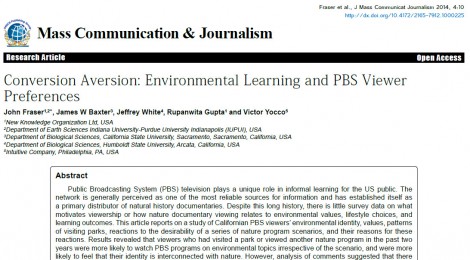
Audiences inspired by hopeful environmental storytelling
Have you ever wondered why environmental documentaries always seem to tell their stories using a “gloom and doom” approach – focusing on the harmful impacts humans have on the environment? Well, you’re not the only one.
Researchers working on the California Environmental Legacy Project were also curious about this question and sought out the opinions of PBS viewers and their preferences with regard to nature documentaries.
Published in the December 2014 issue of the peer review Journal of Mass Communication and Journalism, the new study suggests that this long standing gloom and doom approach to environmental film making is not effective. The study was authored by John Fraser and co-authored by Jim Baxter and three other co-authors.
Based on a survey of public television viewers in California, the study indicates that environmental documentaries are more likely to generate larger viewing audiences when they are framed by hopeful rather than negative stories. The study also indicates that a focus on small-scale personal actions that result in larger impacts will be more effective in promoting positive environmental behaviors than stories focused on more abstract notions of environmental stewardship.
Informed by these results, the California Environmental Legacy Project produced a 2-hour documentary called Becoming California – a hopeful and inspiring story about how Californians are discovering ways to forge new partnerships with nature.
To watch a trailer of Becoming California, click here. For more information about the California Environmental Legacy Project, click here.


